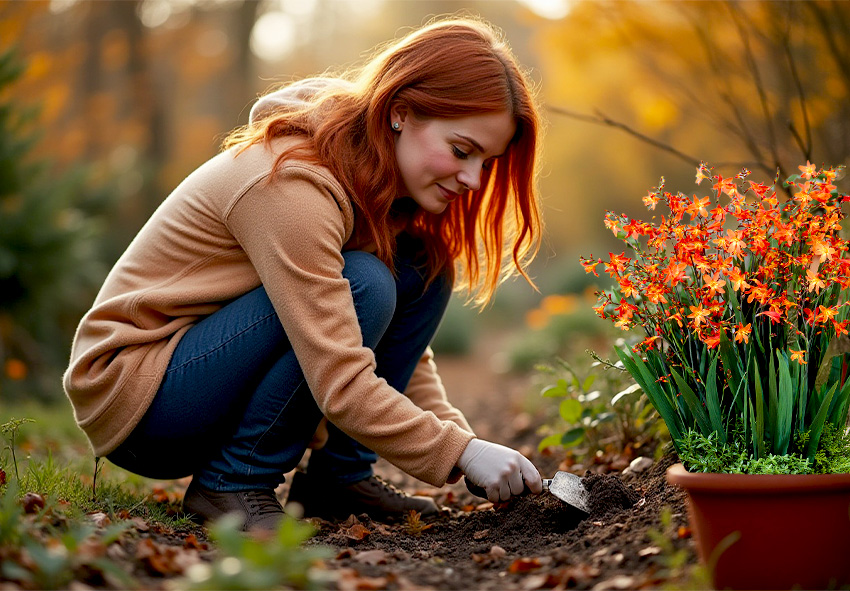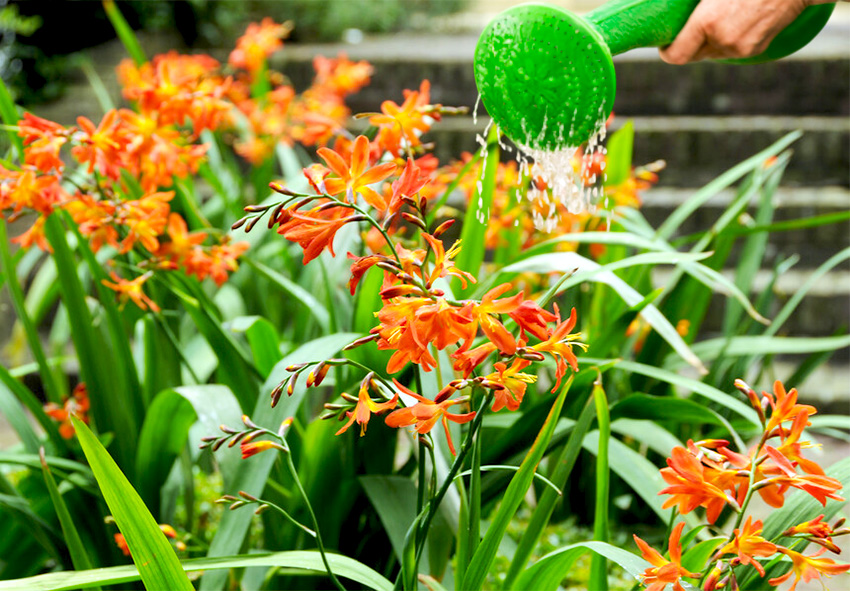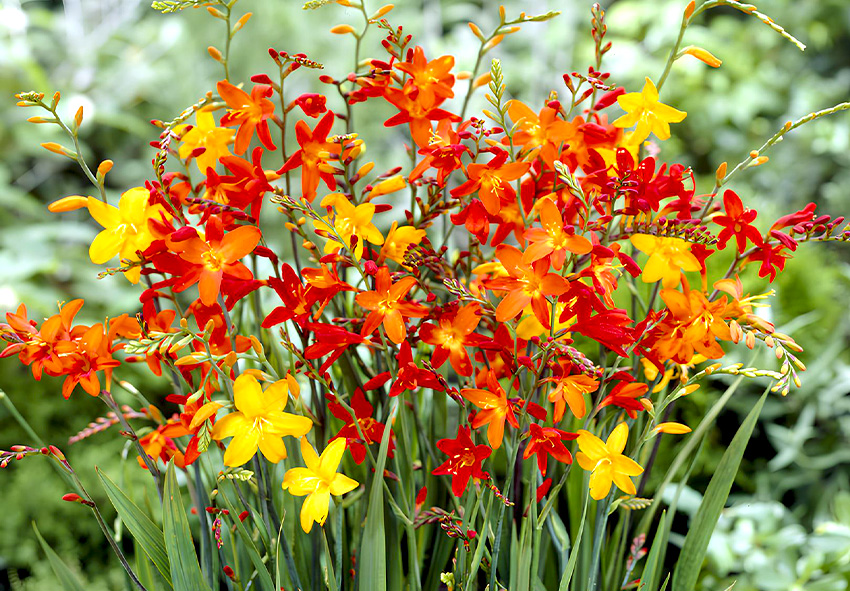Crocosmia, known for its fiery blooms and graceful arching stems, brings a burst of color to summer gardens. These vibrant perennials grow from corms and are both low-maintenance and high-impact once properly established. In this guide, we’ll walk you through everything you need to know about planting Crocosmia successfully—from choosing healthy bulbs to ensuring optimal growing conditions. Our gardening blog is a perfect place to find all the information you need!
Understanding Crocosmia Bulbs
To plant Crocosmia successfully, it’s essential to understand what you’re working with. These vibrant perennials grow from corms, which store energy to fuel seasonal growth. Choosing healthy, high-quality corms is the first step toward stunning summer blooms.
What Are Crocosmia Bulbs (Corms)?
Crocosmia grows from corms, which are similar to bulbs but structurally different. These corms store energy during dormancy, fueling the plant’s growth and flowering in the warmer months. Understanding how they grow helps gardeners plan for long-lasting success.
Choosing Quality Corms
When selecting Crocosmia corms, look for those that are firm, plump, and free of mold or soft spots. Healthy corms are essential for vigorous plants and strong blooms. Avoid dried-out or damaged corms, as they are unlikely to sprout effectively.
When to Plant Crocosmia
Timing is everything when planting Crocosmia bulbs. Plant too early, and you risk rot from cold, damp soil; plant too late, and you miss peak bloom season. Knowing the best time based on your climate ensures strong, healthy growth.
Weather and Soil Temperature Conditions
For successful Crocosmia planting, timing and soil conditions are key. Here are essential factors to consider before you put those corms in the ground:
- Soil Temperature Should Be Above 10°C (50°F): Wait until the soil has consistently warmed to at least 10°C. Cold, damp soil can cause the corms to rot before they sprout.
- Avoid Frost and Cold Snaps: Crocosmia is sensitive to frost. Plant only after the danger of the last spring frost has passed in your region.
- Choose a Mild, Dry Day for Planting: Avoid planting during heavy rain or when the ground is soggy. A mild, dry day gives the corms a stable start and helps prevent rot.
- Ensure Good Drainage: Even in ideal temperatures, poorly draining soil can stunt or kill Crocosmia. If your soil is heavy or clay-based, amend it with grit or compost before planting.
Best Time of Year
The ideal time to plant Crocosmia bulbs is in the spring, once the danger of frost has passed. In colder regions, this typically means planting in late April to early May. In milder climates, planting can begin as early as March for earlier blooms.
Where to Plant Crocosmia

Location plays a major role in how well Crocosmia performs in your garden. These sun-loving plants need warmth and well-drained soil to thrive. Selecting the right spot helps prevent common issues like weak flowering or disease.
Light and Location Requirements
Crocosmia thrives in full sun, producing the most abundant flowers when it receives at least six hours of direct sunlight daily. While it can tolerate partial shade, too little light can reduce blooming. Choose a location with open exposure and protection from strong winds.
Soil Conditions and Drainage
Crocosmia grows best in rich, well-draining soil. Sandy or loamy soils are ideal, as they prevent the corms from sitting in water. If your garden soil is heavy clay, mix in compost or sand to improve drainage and fertility before planting.
How to Plant Crocosmia Bulbs
Planting Crocosmia correctly boosts your chances of vibrant, long-lasting flowers. Proper depth, spacing, and orientation of corms are critical for healthy development. A well-prepared site sets the stage for successful growth and striking displays.
Preparing the Planting Site
Proper site preparation is essential to ensure healthy growth and vibrant blooms from your Crocosmia bulbs. Here’s what to focus on before planting:
- Choose a Sunny Location: Crocosmia thrives in full sun. Select a spot that receives at least 6 hours of direct sunlight daily to encourage tall, upright growth and vivid flowers.
- Test and Improve Soil Drainage: Crocosmia dislikes soggy conditions. If your soil retains water, mix in coarse sand, compost, or grit to improve drainage and prevent root rot.
- Clear the Area of Weeds and Debris: Remove all weeds, roots, and garden debris to reduce competition for nutrients and prevent pests or diseases from establishing.
- Loosen the Soil to a Depth of 6–8 Inches (15–20 cm): Use a garden fork or spade to break up the soil. This improves aeration and makes it easier for the roots to establish quickly.
- Enrich the Soil with Organic Matter: Mix compost or well-rotted manure into the planting area. This boosts fertility and supports strong initial growth.
Depth, Spacing, and Orientation
Plant Crocosmia corms 2 to 3 inches deep with the pointed side facing upward. Space them 6 to 8 inches apart to allow enough room for spreading and airflow. Water the area lightly after planting to help settle the soil.
Immediate Aftercare for Newly Planted Crocosmia

Caring for your Crocosmia doesn’t end after planting. Immediate aftercare, like proper watering and mulching, ensures that corms settle in and sprout strong. Preventing weeds and rot early can save your plants from future stress.
Water Crocosmia thoroughly after planting, ensuring moisture reaches the newly buried corms. After that, water sparingly until growth begins, avoiding soggy soil which can lead to rot. Once shoots emerge, maintain moderate moisture.
Apply a 2–3 inch layer of mulch to help retain soil moisture and suppress weeds. Organic mulches like shredded bark or straw work well. Be sure not to cover the shoots as they emerge to avoid stunting growth.
Tips for Success with Crocosmia Planting
Even experienced gardeners can benefit from a few strategic tips. From choosing good companions to avoiding common pitfalls, these planting tricks help your Crocosmia flourish. A little extra effort can lead to more blooms and healthier plants.
Companion Planting Ideas
Pairing Crocosmia with the right companion plants enhances your garden’s visual appeal and supports healthy plant development. Here are some excellent companion planting ideas:
- Echinacea (Coneflower): These sturdy perennials match Crocosmia’s bloom time and attract pollinators, creating a vibrant and bee-friendly garden.
- Salvia: The vertical spires of Salvia contrast beautifully with Crocosmia’s arching blooms, and both prefer similar growing conditions—full sun and well-drained soil.
- Rudbeckia (Black-eyed Susan): Their golden yellow flowers complement the fiery reds and oranges of Crocosmia, adding a cheerful, late-summer palette to your garden beds.
- Ornamental Grasses: Grasses like Miscanthus or Pennisetum add texture and movement to the garden, providing a graceful backdrop to Crocosmia’s bold blooms.
- Agapanthus (Lily of the Nile): The cool blues and purples of Agapanthus offer a stunning contrast to the warm hues of Crocosmia, making for an eye-catching color combination.
Troubleshooting Planting Issues
If your Crocosmia fails to emerge, check for overly wet soil or corms planted too deep. Poor flowering may result from too much shade or overcrowding. Address issues early in the season for improved performance later.
Conclusion
Planting Crocosmia correctly sets the stage for a summer garden filled with bold, fiery blooms. With attention to timing, location, and soil preparation, you can enjoy stunning results year after year. Visit our online store to order premium Crocosmia corms and start planning your colorful garden today!
Frequently Asked Questions (FAQs) about Planting Crocosmia Bulbs
1. When is the best time to plant Crocosmia bulbs?
The ideal time to plant Crocosmia bulbs is in spring, after the danger of frost has passed. Planting at this time gives the bulbs plenty of warmth and moisture to establish roots and begin strong growth for summer blooming.
2. How deep and how far apart should I plant Crocosmia bulbs?
Plant Crocosmia bulbs about 3–5 inches deep and space them 6–8 inches apart. This spacing allows for proper airflow and room to grow, reducing the risk of overcrowding and disease.
3. Can Crocosmia grow in partial shade?
While Crocosmia prefers full sun for the best blooms, it can tolerate partial shade—especially in hotter climates. However, too much shade may lead to fewer flowers and leggier growth.
4. Can I order Crocosmia bulbs from your online store?
Yes! You can easily order high-quality Crocosmia bulbs from our online store Dutch-bulbs.com. We offer a variety of vibrant cultivars that ship directly to your door, ready for planting. Check out our full selection and seasonal offers today!
5. Do Crocosmia bulbs need to be lifted for winter?
In colder climates (zones 5–6 and below), it’s best to lift Crocosmia bulbs after the foliage has died back. Store them in a cool, dry place over winter to prevent freezing. In milder zones, bulbs can be left in the ground with a layer of mulch for protection.
Published: 03.06.2025

